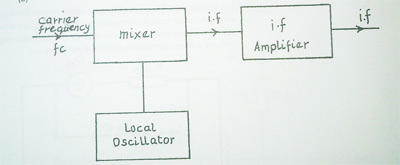The expected answers were:

Explanation:
Frequency mixing is achieved with a mixer and local oscillator.
Two separate r.f. signals are fed into the mixer, the received carrier frequency (fe) and
local oscillator frequency (fo)
The mixer produced four different frequencies, i.e.
(i) fe and fo: The two original frequencies
(ii) fo + fc: Sum of frequencies
(iii)fo - fc: Difference of frequencies
(iv) if: The intermediate frequency
(b) (i) Frequency modulation:
= 10.7MHz
(ii)Amplitude modulation:
= 455 KHz/470KHz/465KHz
The question was on Communication Systems. The topic did not enjoy much
tutorship/readership since no candidate got the block diagram well, though, many
answered part (b) correctly. The performance was less encouraging.



